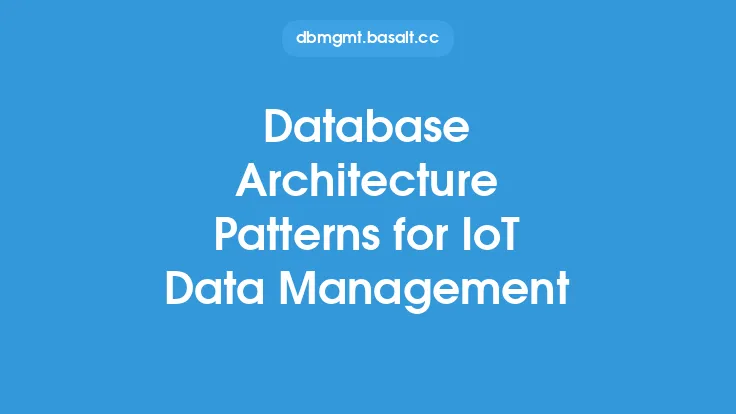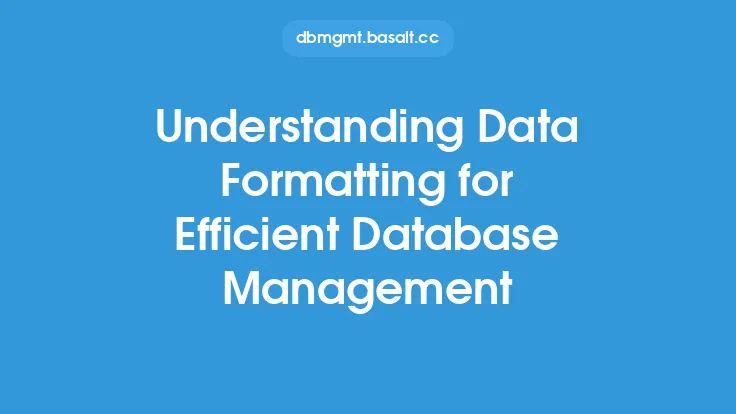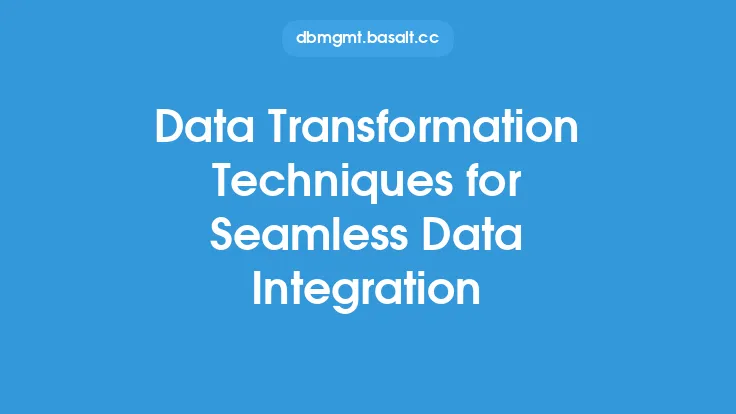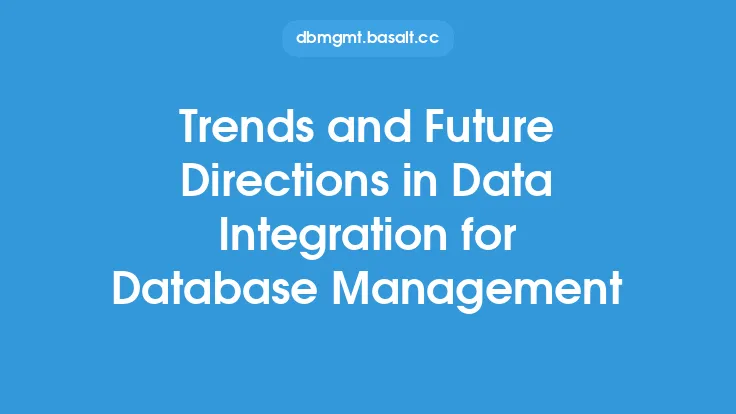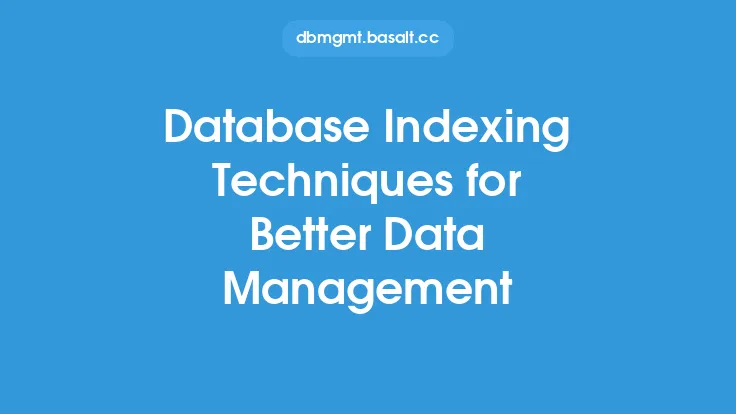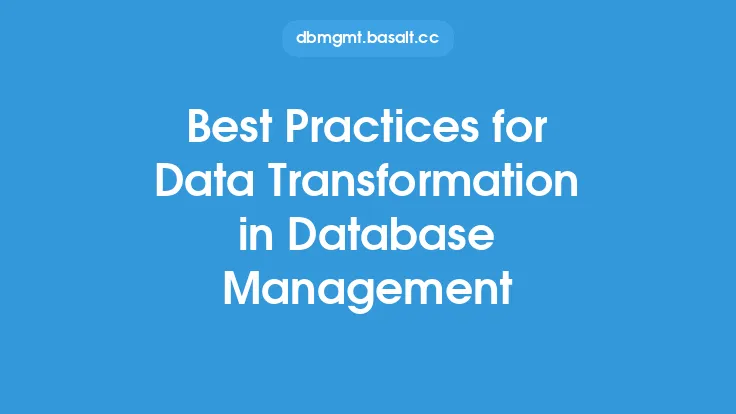Data integration is a critical component of database management, as it enables organizations to combine data from multiple sources into a unified view, providing a single, accurate, and up-to-date picture of their business. This is achieved through various techniques, which are designed to handle the complexities of data integration, including data quality, data transformation, and data mapping. In this article, we will delve into the different data integration techniques that are used to achieve seamless database management.
Introduction to Data Integration Techniques
Data integration techniques are methods used to combine data from multiple sources into a single, unified view. These techniques are designed to handle the complexities of data integration, including data quality, data transformation, and data mapping. There are several data integration techniques, including ETL (Extract, Transform, Load), ELT (Extract, Load, Transform), and ESB (Enterprise Service Bus). Each technique has its own strengths and weaknesses, and the choice of technique depends on the specific requirements of the organization.
ETL (Extract, Transform, Load) Technique
The ETL technique is a traditional data integration method that involves extracting data from multiple sources, transforming it into a standardized format, and loading it into a target system. The ETL process typically involves three stages: extract, transform, and load. In the extract stage, data is extracted from multiple sources, such as databases, files, and applications. In the transform stage, the extracted data is transformed into a standardized format, which involves data cleaning, data mapping, and data aggregation. In the load stage, the transformed data is loaded into a target system, such as a data warehouse or a database.
ELT (Extract, Load, Transform) Technique
The ELT technique is a variation of the ETL technique, where the data is loaded into the target system before it is transformed. This technique is useful when the data is too large to be transformed in memory, or when the transformation process is complex and requires significant computational resources. The ELT technique involves two stages: extract and load, and transform. In the extract and load stage, data is extracted from multiple sources and loaded into a target system. In the transform stage, the loaded data is transformed into a standardized format, which involves data cleaning, data mapping, and data aggregation.
ESB (Enterprise Service Bus) Technique
The ESB technique is a data integration method that uses a centralized bus to integrate data from multiple sources. The ESB acts as a messaging system, where data is published to the bus and subscribed to by other applications. The ESB technique is useful when the data integration process involves multiple applications and systems, and when the data needs to be integrated in real-time. The ESB technique involves three stages: publish, route, and subscribe. In the publish stage, data is published to the bus by applications and systems. In the route stage, the published data is routed to the appropriate applications and systems. In the subscribe stage, applications and systems subscribe to the data published on the bus.
Data Mapping and Data Transformation
Data mapping and data transformation are critical components of data integration techniques. Data mapping involves creating a mapping between the source data and the target data, which defines how the data is transformed and loaded into the target system. Data transformation involves converting the source data into a standardized format, which involves data cleaning, data aggregation, and data formatting. Data mapping and data transformation are used to ensure that the data is consistent and accurate, and that it meets the requirements of the target system.
Data Quality and Data Governance
Data quality and data governance are critical components of data integration techniques. Data quality involves ensuring that the data is accurate, complete, and consistent, and that it meets the requirements of the target system. Data governance involves defining the policies and procedures for managing data, including data security, data privacy, and data compliance. Data quality and data governance are used to ensure that the data is trustworthy and reliable, and that it meets the requirements of the organization.
Real-Time Data Integration
Real-time data integration involves integrating data in real-time, as it is generated by applications and systems. Real-time data integration is useful when the data needs to be integrated quickly, such as in financial trading, healthcare, and logistics. Real-time data integration involves using techniques such as messaging, streaming, and event-driven architecture to integrate data in real-time. Real-time data integration requires significant computational resources and network bandwidth, and it requires careful planning and design to ensure that the data is integrated correctly and efficiently.
Cloud-Based Data Integration
Cloud-based data integration involves integrating data in the cloud, using cloud-based services and platforms. Cloud-based data integration is useful when the data is generated by cloud-based applications and systems, and when the data needs to be integrated quickly and efficiently. Cloud-based data integration involves using techniques such as cloud-based ETL, cloud-based ELT, and cloud-based ESB to integrate data in the cloud. Cloud-based data integration requires careful planning and design to ensure that the data is integrated correctly and efficiently, and that it meets the requirements of the organization.
Conclusion
In conclusion, data integration techniques are critical components of database management, as they enable organizations to combine data from multiple sources into a unified view. The choice of data integration technique depends on the specific requirements of the organization, including data quality, data transformation, and data mapping. ETL, ELT, and ESB are popular data integration techniques, each with its own strengths and weaknesses. Real-time data integration and cloud-based data integration are also important techniques, which involve integrating data in real-time and in the cloud, respectively. By using these techniques, organizations can ensure that their data is accurate, complete, and consistent, and that it meets the requirements of their business.
